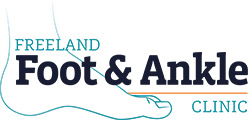A great deal of thought goes into what may seem like a simple run.
You don your favorite running gear: shorts, shirt, and accessories like your water bottle and fuel for longer runs. It's crucial to remember your headphones, and those are only good if your phone is charged with your favorite running playlist queued.
Running shoes may be the most critical piece of equipment, and any runner can tell you that a pair of shoes can make or break any run. A good pair of socks, a splash of sunscreen (always wear that SPF!), and you're ready to hit the pavement.
Or are you?
All the time and money you spend on your running gear could be useless if your gait is off. I'm here to make sure that doesn't happen.
What is a Running Gait?![stretching before a run]()
The term running gait refers to the motion of your body, especially your legs and feet, when you're running. It's important to be mindful of the very unique way that every runner moves along the trail or sidewalk. Your gait should be taken into account when purchasing new running shoes. When you have pain or injuries, your running gait can even tell your provider why you've sustained that injury. Runners with certain gait tendencies may be more likely to sustain rolled ankles, while others may be at-risk for heel pain, Achilles tendonitis, and metatarsalgia.
A gait analysis can make sure that those injuries don't return.
What Does a Gait Analysis Show?
When performing a gait analysis, the provider will watch you run and walk, marking certain points as you go.
The purpose of gait analysis is to examine the length of a runner's stride, their foot placement upon landing (heel striking, toe-off), their arm swing when in motion, and the presence of pelvic tilt. Gait analysis can also bring to light any limping exhibited by the runner.
Gait analysis can be performed by foot and ankle specialists, sports medicine specialists, physical therapists, and other medical practitioners. Outside of the doctor's office, you can find gait analysis complementary at most specialty running-shoe stores. If you live in Mid-Michigan, Runner's Athletic Company is a great option for all of your running gear and gait-analysis needs.
At-Home Gait Analysis
You can also perform your own gait analysis from your home. There are two at-home gait analysis methods to choose from:
- Check the wear pattern on an existing pair of shoes. It's best to use a pair of running shoes with plenty of miles behind them, as this will give a more clear view of the way you wear out your shoes. Where is the rubber most worn? This indicated the places you put the most pressure on.
- Perform the 'Wet Test.' Wet the bottom of your foot and take a few natural steps across a piece of cardboard or even a brown paper grocery bag.
 Both of these methods will show you if you have flat, high, or neutral arches. Knowing what type of arches you have is an essential part of gait analysis.
Both of these methods will show you if you have flat, high, or neutral arches. Knowing what type of arches you have is an essential part of gait analysis.
Those with flat feet may experience overpronation, or the inward twisting of the feet when walking or running. On the other side of the spectrum, people with high arches may suffer from supination, which is an outward twisting of the feet. Additionally, high-arched runners may be at a greater risk for shin splints and other bone-related sports injuries.
Anyone who thinks those with neutral arches has been blessed with a life void of any issues or injuries is sorely mistaken. In fact, those with neutral or natural arches may also experience frequent shin splints and ankle pain.
Knowing your arch type will help you decide on a pair of shoes and inserts. It will also help you, your provider, and any trainers or coaches highlight potential gait issues so that form-correction measures can be taken before those small aches and pains become chronic.
Gait Analysis for Orthotics![fitting orthotics]()
Contrary to popular belief, you don't have to have existing foot pain to reap the benefits of orthotics. We could all use a little more support, after all. If you do have existing gait problems, orthotics are a great tool to help correct them.
The coolest part? The process of being fitted for custom shoe inserts is a whole gait analysis on its own! Most modern orthotic-specialists and podiatrists use 3D scanning technology to custom-fit your orthotics. A clear image of your foot structure and a high-tech analysis of your gait allows your new custom inserts to be 100 percent custom tailored to you and your needs.
Who Should Have a Gait Analysis?
"Should I get a gait analysis even though I'm not a runner?"
Absolutely! Everyone can benefit from gait analysis. Not only can it help predict potential issues you may experience in the future, but it can help you pick better footwear. For children, having a gait analysis performed when they're still growing could be the difference between a serious deformity caused by improper gait and a simple fix that will set them up for a pain-free future.
If you've never had a gait analysis done, don't wait! Dr. Dailey, a runner himself, has brought all the tools you need to determine and improve your gait right to your own backyard. Located less than 30 minutes from Saginaw, Bay City, and Midland, Freeland Foot and Ankle Clinic is Mid-Michigan's one-stop shop for sports injuries, heel pain, pediatric podiatry, and more. Relief is possible, and appointments are available now!



